
|
Izumi-no-Kami Kunisada and his Mei
Tsuguyasu Wada and Danny Massey
The present authors were motivated to write this article as the result of studying a sword that was acquired in February, 2007, at the Florida Token Kai sword show in Tampa. At the show, a young couple stopped by the author's (TW) table and showed him a Gunto-mounted katana bearing the signature of Izumi-no-Kami Kunisada. The author had an impression that the mei was genuine and by the Shodai. Subsequently, he purchased the blade. As is often the case in the study of swords, after more detailed study and contemplation, he later started being suspicious of the mei. Also, it was puzzling to observe that the habaki of the sword, a nice old hitoe habaki which added to his good first impression of the sword, did not fit tightly to the blade. When an old habaki is present, it can provide important clues to the background of the blade. The sword is suriage and it is possible that it may be the one original to the blade before it was shortened. However, he also thought that the possibility of it being unoriginal could not be entirely dismissed.
A few weeks later, at the OVMS "Show of Shows" held in Louisville, KY, the second author (DM) saw this Kunisada and his impression was also good. Then, the two authors worked together to investigate the mei of Kunisada. This article is part of the results of the investigation.
Incidentally, the story ended happily. One of the authors (DM) sent an oshigata and photographs of the mei to Mr. Tanobe Michihiro of the NBTHK . In his kind response, Tanobe explained that the mei is authentic and a jishin-mei of the shodai Kunisada. Jishin-mei is a term used to refer to a signature cut by the craftsman's own hand, rather than a mei cut for the master by his student or, daimei. The sword eventually received an NBTHK Tokubetsu Hozon paper.
The first generation Izumi-no-Kami Kunisada
The first generation Kunisada was born in the seventeenth year of Tensho (1589). His place of birth was central Kyushu, in Obi-han in the prefecture of Hyuga. He became a student of Horikawa Kunihiro, who was also from Obi, Hyuga. Many people believe that Kunisada was actually a student of Kunitomo, one of Kunihiro's leading students. It is also most probable that Kunitomo was Kunihiro's nephew. Like Kunihiro and Kunisada, Kunitomo was also born in Obi, Hyuga.
After spending several years as an apprentice under Kunitomo, Kunisada became independent and moved to Osaka. Another student of Kunitomo's, Kunisuke, also moved to Osaka about this same time.
Osaka was then a newly developing town. Toyotomi Hideyoshi began construction of his huge castle there in 1584 and it was completed in 1585. Hideyoshi died in 1598 and the lord of the castle became his son, Hideyori. The castle was destroyed by Tokugawa Ieyasu in the so called Osaka Winter and Osaka Summer campaigns of 1614-1615. The city of Osaka was also destroyed. Hideyori and his mother, Yodo, both committed suicide at the end of the war. The Tokugawa Shogunate then established an office in Osaka in 1619. It was called the Osaka Jodai. They started rebuilding the city and the castle at that time.
Kunisada received the title of Izumi-no-kami in the ninth year of Genna (1623). Because examples exist, such as the blade dated 1621 and signed "Sesshu Osaka ju Fujiwara Kunisada (Fig .1), we know that Kunisada moved to Osaka before being awarded the title of Izumi-no-kami. Considering the time Osaka Jodai was established and the date of this sword, Kunisada probably moved to Osaka between 1619 and 1621.
Kunisada worked steadily from 1623 to around 1645. He signed most of his blades with the mei, "Izumi-no-kami Fujiwara Kunisada". Sometimes he used "Izumi-no-kami Kunisada" or "At Osaka Izumi-no-kami Kunisada". Kunzan Honma pointed out that the reputation of Kunisada's work is that even his average products are of high quality (1,2). Kunzan wrote that he believed that the quality of Kunisada's average blades are better than those made by the second generation Kunisada (Shinkai), although the latter's best products are more appreciated than the first generation Kunisada. On the other hand, the first generation Kunisuke, who had the title of Kawachi-no-kami and moved to Osaka at nearly the same time as Kunisada, has a different reputation. Kunisuke's reputation is that the difference between his good products and not-so-good products can be very wide.
Kunisada's second son, who succeeded the name of Kunisada and later used the name Shinkai, was born in 1630. At the age of 15, he started signing daimei (the student signing the master's name, under support and direction of the master, for the master) for his father. Hideo Yoshida published his study on the daimei of the second generation Kunisada for his father (3). In writing this article, the present authors are very much indebted to Yoshida's paper.
From here forward in this paper, for the sake of clarity and according to tradition, the first generation Kunisada with be written as "Oya Kunisada" (Oya means parent) and the second generation Kunisada will be written as "Shinkai Kunisada".
According to Yoshida, Shinkai Kunisada started daimei for his father in the second year of Shoho (1645) with a sosho mei ("grass" or running/cursive style mei) ( Fig.4, 5) . Yoshida said that the reason for starting with a sosho mei may be as follows: Since this daimei was still unofficial, Oya Kunisada did not want Shinkai Kunisada to put the same kaisho-mei (normal or "block letter" style mei), written by an obviously different hand, on the daimei products. Because sosho mei was new, nobody would immediately notice that this was daimei. This may be a reasonable guess.
The outline history of the two Kunisadas, as Yoshida described, is as follows:
In the fourth year of Shoho (1647), Shinkai Kunisada finished his apprenticeship and took the main role in the shop. Oya Kunisada submitted a letter to his lord to ask permission to retire. Interestingly, Oya Kunisada sought this permission from Lord Sukehisa Ito, Governor of Obi in Hyuga, even though it had been more than thirty years since he had left his native prefecture. That was probably the way of living at that time, particularly for a swordsmith, an important weapon supplier.
In January of the fifth year of Shoho (1648), Lord Sukehisa Ito responded to Oya Kunisada with the suggestion that he purpose this same request to the Lord's staff.
On February fifteenth of that year, the nengo (era name) of Shoho ended and the new nengo of Keian began.
Late in the first year of Keian (still 1648) daimei by Shinkai Kunisada for Oya Kunisada was approved. Shinkai Kunisada started kaisho mei as daimei for his father, and stopped making sosho mei. There is an exceptional sosho mei blade dated as the third year of Keian (1650), but Yoshida (3) thinks from the way of writing that its omote mei was actually made in the fourth year of Shoho (1648). Oya Kunisada continued making swords, but the mei were all signed by Shinkai Kunisada. The main reason for this, according to Yoshida, is that Oya Kunisada has a vision problem. Oya Kunisada's mei in his later years often shows mis-chiseling.
Oya Kunisada became ill around the spring of the fourth year of Keian (1651). He died at the age of 63 on May fifth in the fifth year of Keian (1652).
Mei by Oya Kunisada and Shinkai Daimei
Figure 1: Two examples of early mei by Oya Kunisada. These were made before he was awarded the title of Izumi-no-kami. The 1621 mei, Fig 1a, is showing a style of writing "Kuni" which is different from his mature works and closer to the style of "Kuni" used by his teacher, Kunitomo. Pleaase compare to the oshigata of Kunitomo's mei shown next to it (10). The blade shown in Fig 1b, which shows the "Kuni" of his mature works, was probably made sometime between 1621 and 1623.
Figure 2: Oya Kunisada katana with a typical mei and representative hamon.
Figure 3: The mei of the katana that the author (TW) purchased as compared with one from reference 5.
Figure 4: Comparison of a mei by Oya Kunisada's own hand (jishin-mei) and a Shinkai Kunisada daimei. Note that the clearest difference is the point on the upper-right corner of "Kuni". A point in "Fuji" also shows different directions (9).
Figure 5: Additional examples of Oya Kunisada's jishin-mei and Shinkai Kunisada's daimei. Figure 5b, a katana dated the twenty-first year of Kanei (1644) is probably the last jishin-mei by Oya Kunisada. Yoshida pointed out that there are two returns on the last vertical line of "Izumi", an example that Kunisada was sometimes out-of-control in the sighing of his mei during the last few years of his life. Two Shinkai daimei are shown here that are both dated August of the second year of Kanei (1649). This was the first year of Shinkai's kaisho daimei. His sosho daimei started in 1645, as mentioned above, and ended in 1650. An example shown here is dated the third year of Shoho (1646).
Figure 6: After the Oya Kunisada's era ended, Shinkai Kunisada started his jishin-mei. A clear difference in the Shinkai's jishin-mei from his daimei is the vertical stroke, instead of a slant arc, on the left-side in the crown of "kami", as shown in this figure (3).
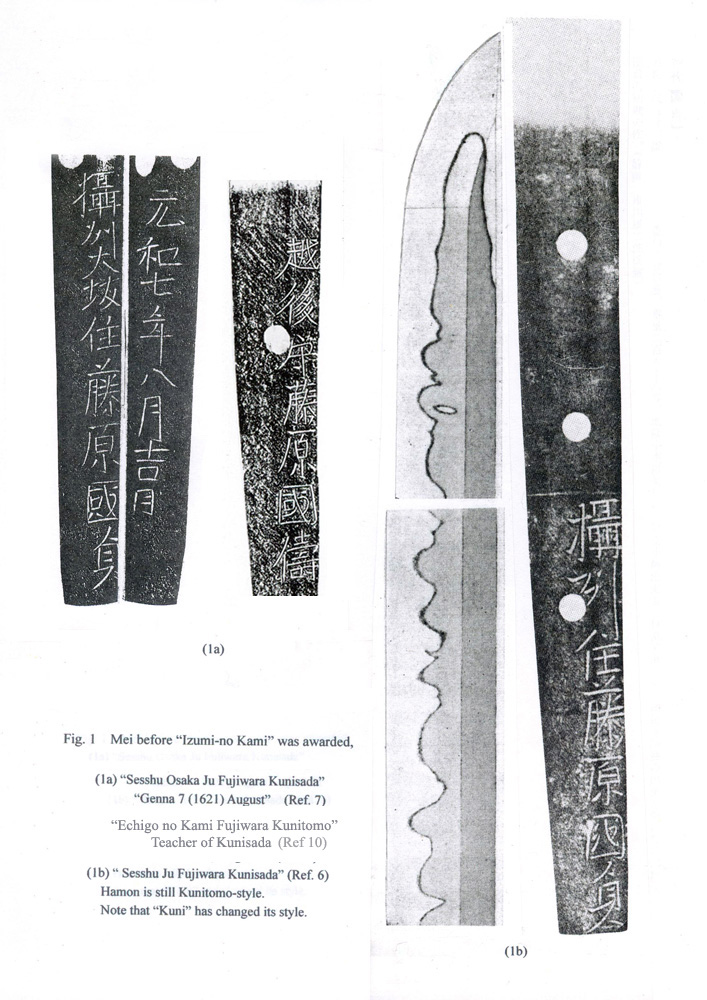
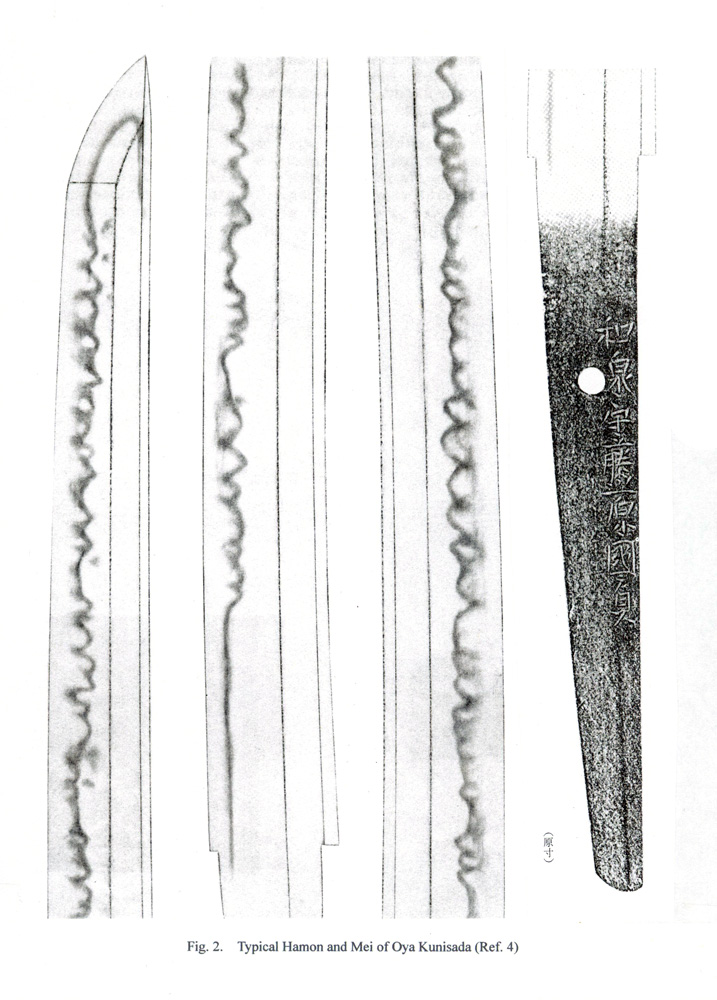
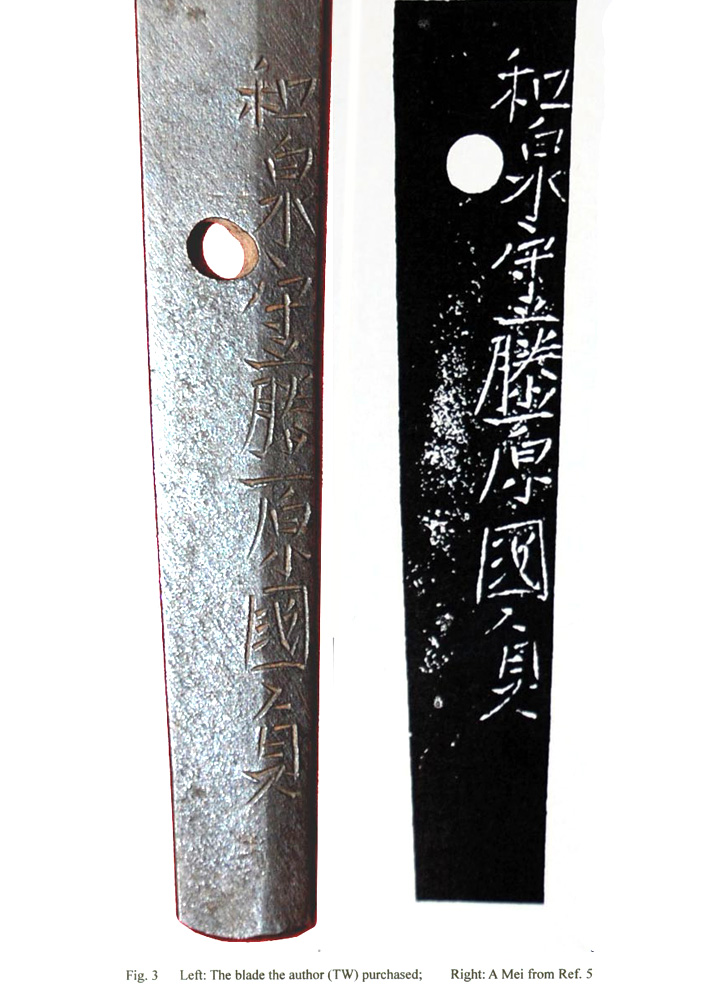
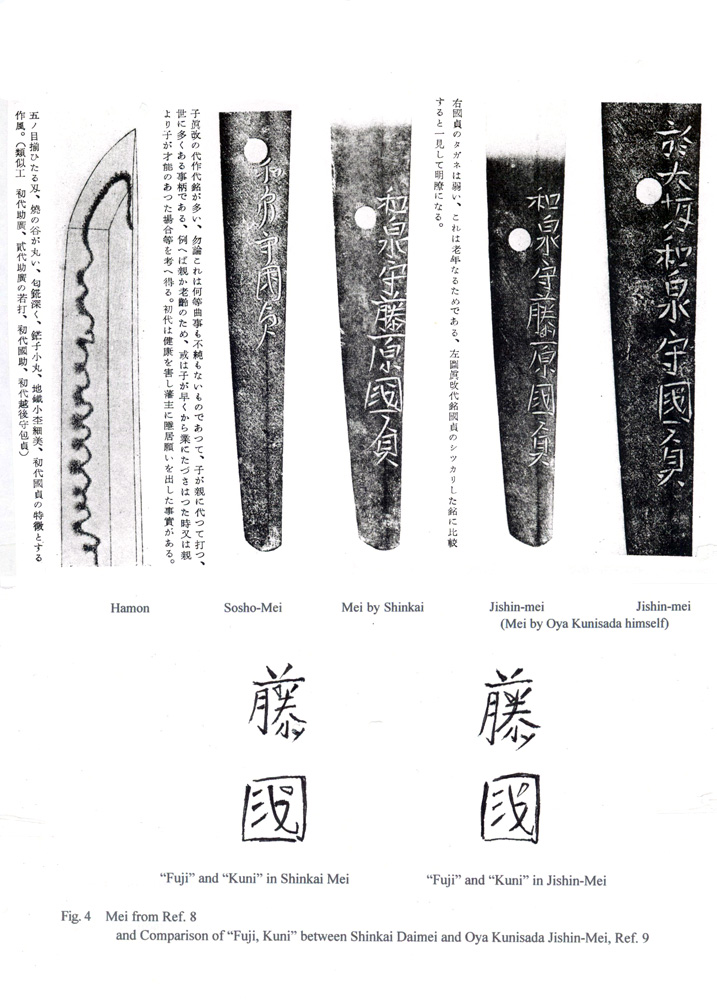
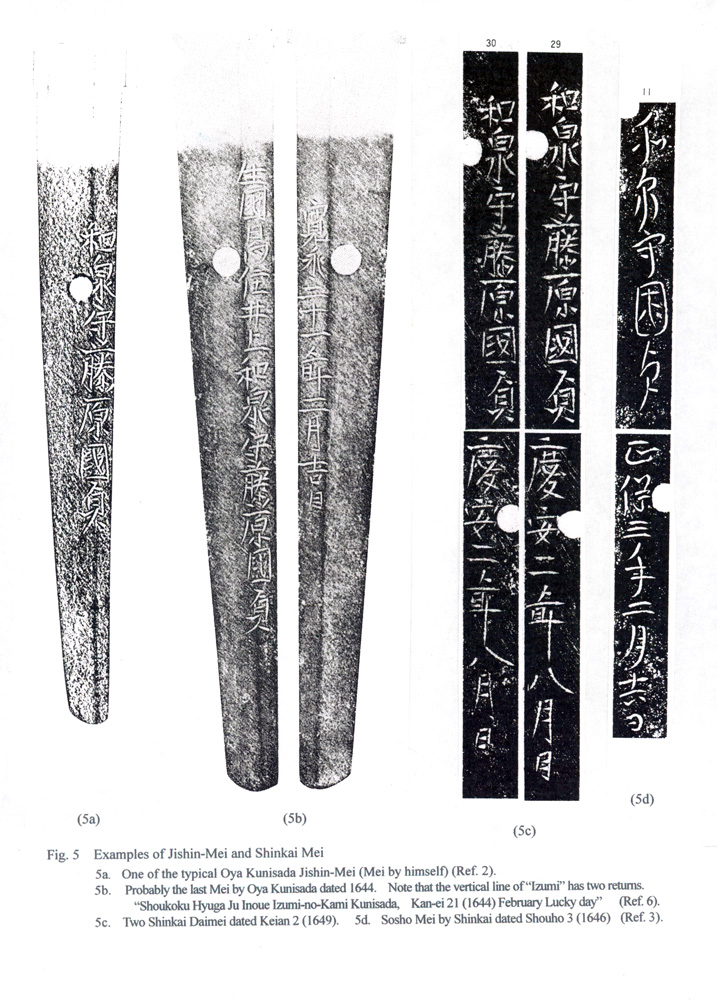
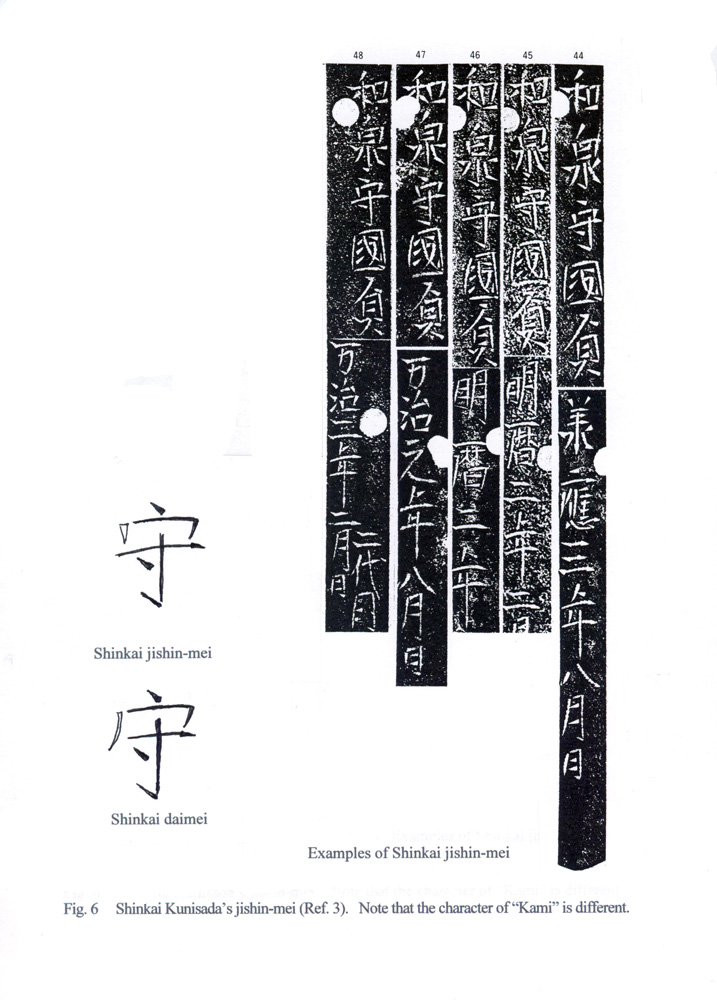
References:
(1) Kunzan Honma, "Diary of sword observation," Token Bijutsu No. 260, (September 1978), p.36.
(2) Kunzan Honma, "Diary of sword observation," Token Bijutsu No. 261, (October 1978), pp.33-34.
(3) Hideo Yoshida, "A Consideration on Kunisada Daimei," Token Bijutsu No. 564, (January 2004), pp. 9-29.
(4) Token Bijutsu Shijo Kantei, Token Bijutsu No. 356/358, (September/November 1986).
(5) Keido Nakamiya, et al, "Osaka Shinto Zufu," (1967), Yuzankaku
(6) Yoshio Fujishiro, Mitsuo Shibata, "Shinto-Shu (Hamon and Signature)," pp. 34, 35, (The 3rd Ed., 1971) Token Shibata.
(7) Kazuo Iida, "Tomei Soran," pp. 121-123, (1984), Token Shunju Shinbunsha.
(8) Yoshio Fujishiro, "Nihon Toko Jiten, Shinto-Hen" (The 12th Ed., 1978) pp. 247, 248, Fujishiro Shoten.
(9) Michihiro Tanobe, Lecture at the Florida Token Kai conference, Tampa, FL, February 15, 2003.
(10) Kanzan Sato, "Kanzan Shinto Oshighata Dictionary" (2005) p. 85.
|